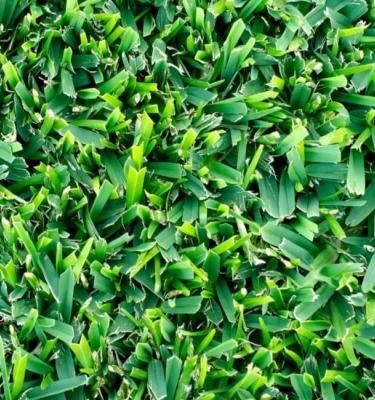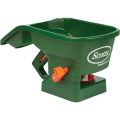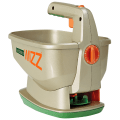

The Ultimate Guide to Caring for your Buffalo Grass Lawn
Buffalo grass has a reputation for being scratchy and coarse, but this is no longer the case for modern varieties. These newer varieties are often known as ‘soft leaf buffalo grass’ and can be quite lush.
Buffalo grass types
All varieties of Buffalo grass have wide leaves, so it also has a place in a more ornamental garden, where it will provide an attractive thick sward of green throughout the year.
There are several varieties of Buffalo grass to choose from, depending on how you like to use your garden:
- Matilda Buffalo. A good choice for the environmentally conscious gardener, this variety is particularly tolerant of drought conditions and needs minimal watering even in very dry periods.
- Palmetto Soft Leaf Buffalo. Perfect for a busy family garden, this variety is especially resilient to heavy footfall. It’s also very soft, so gentle under foot for children and pets.
- Prestige Buffalo. One of the darkest lawn varieties available, this variety provides a lovely deep green colour all year round.
- Sapphire Soft Leaf Buffalo. Known for its particularly soft feel under foot. Great for a garden in which relaxing on the lawn is a favourite activity.
- Shademaster. A traditional and vigorous variety of Buffalo grass, Shademaster will quickly crowd out other plants, so is good for areas where weeds have previously thrived.
- Sir Walter DNA certified. This variety is particularly good in very shady conditions. As with all Buffalo grass, it still needs some direct light, but it is the most tolerant of minimal exposure to sunlight.
Consider what matters to you most in the backyard. All modern Buffalo grass varieties are hard-wearing and will excel in the trickiest of gardens.
Other types of grass which might also be suitable for your garden are explained in out handy guide to choosing the right lawn grass.
What you'll need to grow a buffalo grass lawn
Buffalo grass is best installed as turf. Whilst it might seem expensive compared to seed, it is a much more reliable way to establish a new buffalo lawn. Buffalo grass seed is rarely viable, and even professional growers will usually grow new turf from existing areas of grass that are deliberately allowed to spread.
The turf will have been freshly cut by the grower and the roots will benefit from being reunited with the soil beneath, so lay the lawn as soon as possible after delivery.
To lay Buffalo turf and give the new lawn the best possible start, you will need a rake and roller. Use these to help you to level the area and reduce air pockets in the soil. Watch our video of simple steps to learn how to lay a new lawn.
Roll the Buffalo turf afterwards to increase contact between the roots and the soil. Give it a good drench several times a week using a sprinkler until it has established.
Laying Buffalo grass in the spring will allow it to grow more quickly with the warming weather, helping it to establish before the hotter months. Autumn is also fine, as the grass can grow without enduring the stresses of extreme weather. If planting it at another time of year, just make sure that appropriate moisture levels are maintained.
Where to plant and grow your buffalo grass
Buffalo grass is tolerant of most soil conditions, although will do particularly well in sandy soil. Compared to other types of grass, Buffalo has deep roots which will tolerate drought better than many.
It is best suited to warm conditions where temperatures are consistently 20C (68F) upwards. It will stop growing if temperatures fall below 10C (50F) and is sensitive to frost, so avoid any areas which experience sustained cold weather.
Buffalo grass is tolerant of salty air, so it’s well suited to coastal conditions. It will also withstand considerable shade and will survive with as little as four hours of light per day, making it perfect for areas of the yard that do not receive much direct sunlight.
Caring for buffalo grass
Buffalo grass is native to warmer parts of the world, so the more you can do to replicate hot and moist conditions, the healthier the lawn will be. It is very resilient to dry conditions though, and should look good all year around without needing much attention. Only water when it looks dry - even brown and wilted grass will usually recover. If the lawn does need to be watered, do it in the morning to give it a chance to soak in before the peak of the heat.
As with any good looking lawn, it needs regular mowing, weeding and feeding to keep it at its best. Mowing will encourage the grass to put on new, soft and lush growth. Ideally mow to 2” (4-5cm) every week. Give the edges as much attention as anywhere - a sharp edge gives a neat finish to the whole lawn.
Keep the area free of weeds by using a weed killer which is specially formulated for use on Buffalo lawns. Conventional lawn weedkillers can damage Buffalo grass, so check the label carefully. Scotts lawn builder Buffalo Weed, Feed & Green Up Liquid Lawn Fertiliser can be used all year round, and will help to feed the Buffalo lawn at the same time.
Add a slow release fertiliser to the Buffalo lawn in late spring, mid summer, and late autumn. Water lightly but evenly before and afterwards. Scotts Lawn Builder™ Buffalo Slow Release Liquid Lawn Fertiliser is a liquid fertiliser which can be applied directly from the container, using the hose provided. Alternatively, Scotts Lawn Builder™ Buffalo Slow Release Lawn Fertiliser can be applied using Scotts® Handy Green Fertiliser Spreader, which will ensure even distribution of the feed.
Remove fallen tree leaves from the lawn throughout autumn and winter, using a spring-tined rake. Dethatch the lawn using a lawn thatch rake in late Spring. Doing this will help to maintain good air circulation and light levels. Remove leaves and grass clippings to the compost heap.
Although Buffalo grass is durable and does not need much maintenance, a little care and nourishment will mean that it remains soft and pleasant.
Common buffalo grass pests & diseases
Buffalo grass is very resilient to most pests and diseases, and the most important way to maintain a healthy Buffalo lawn is to feed it. Common pests and diseases affecting buffalo lawn can usually be resolved easily:
- Why are there brown spots on my Buffalo grass? This is probably ‘brown patch', a fungal disease which can cause unsightly circular areas on the lawn. It can be managed by reducing watering in the evening, and regularly applying a fertiliser.
- Why does my Buffalo lawn feel spongy? Buffalo grass is a mat-forming perennial, sending out stolons/runners above the soil surface as it spreads. This can cause old growth, known as thatch, to build up on the surface of the soil. Remove this with a special lawn thatch rake, or verticutter, to increase airflow around the base of the plants.
- Why is my Buffalo grass turning yellow in winter? The cause is usually a lack of water or lack of nitrogen. Check that the lawn is not too dry and water if needed, although this is rarely a problem for Buffalo grass. More likely is an imbalance of nutrients. Use a high-nitrogen feed specially formulated for Buffalo grass to restore the right levels of nutrients, such as Scotts Lawn Builder™ Buffalo Weed, Feed & Green Up Liquid Lawn Fertiliser.
How do I get rid of weeds in Buffalo grass? Pull out weeds by hand, or use a a selective herbicide such as Scotts Lawn Builder™ Bindii Weedkiller. Only use a weedkiller which is specially formulated for use with Buffalo grass, as other weedkillers may kill your buffalo lawn.



